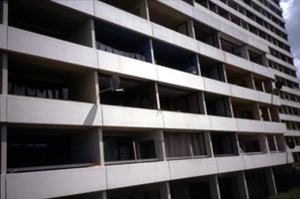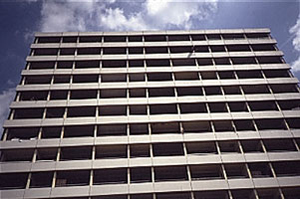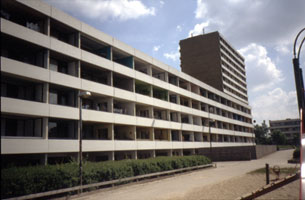| Katya Sander | e@katyasander.net |
| Vollsmose and the painting of balconies Painting app. 200 balconies in different colors in collaboration with inhabitants. A site-specific project for CUDI - Center for Urbanitet, Dialog og Information, Vollsmose/Odense 2001-2002   In small fishing villages along the coasts of Denmark, there was a tradition of painting fishermen's houses in bright, spectacular colors. The colors made it easier to spot the homes from far a way at sea. Today, many of the houses still wear significant colors. Vollsmose, a complex of buildings at the edge of Odense, was built in the seventies under the influence of mass-modernism - huge high-rises combined with large flat, green areas and smaller housing blocks. The area, for the past couple of years has been stigmatized by the Danish Media as an area filled with social problems. The media ascribes these problems to the fact the low percentage of inhabitants with so-called "Danish" backgrounds. Currently, 58 nationalities are represented in Vollsmose. The area consists mostly of parking lots and huge lawns and a sparse playground here and there. The high-rises, as seen from the highways near-by, with their repetitive pattern of gray balconies, signify a stigmatized area that "most people" want to stay away from. I was invited to do a project in Vollsmose by CUDI (Center for Urban Dialogue and Information). My project, in the form of a suggestion and a task, involves offering the inhabitants of one of the high-rises to choose a color that each would like to see painted on their particular balcony. I then get the paint and paint the balcony. Hopefully some residents would help me. Swedish Flügger agreed to sponsor a large amount of the paint. However it turns out that the rules and regulations for what can be done there are strict and not easily negotiable. After long time I gave up carrying the project through. As such, it has become a project about the Danish official administrative apparatus, as well as about urban planning, modernism and social democracy. Here, it seems the idea of "equality" becomes interesting, especially when seen in the light of the way it has slowly been translated into "sameness" in Dänish context. To me it seems as if within Danish welfare society there has been created a social pattern - based on aesthetic homogeneity - where it is not necessarily so important weather we are equal or not (weather we have the same rights or not), but rather that we look the same. Any attempt--consciously or not-consciously--to look remarkably different is seen as a provocation to this very particular version of 'equality' (read 'sameness')--and thus ultimately read as un-solidaric or even anti-social. Sammeness.  |